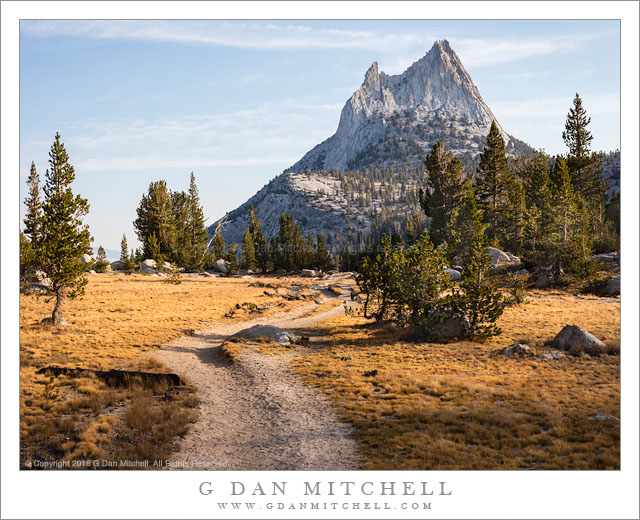From time to time people ask what techniques I use to create the simple frames for versions of my photographs that I post online. A while ago I wrote about this: Creating Frames for Online Photos: My Method. The explanation involves the use of Photoshop CS3, but the technique is essentially the same in the current version of the program.
You can read the details at the link above, but the process is basically fairly straightforward. I use Image –> Canvas size to add a series of borders to the original image: a one-pixel gray border immediately around it, a larger white border beyond that with a bit more width at the bottom, and finally a one-pixel black border at the outer edge. I turn this into an action that I can apply by selecting it and clicking a button to run it.
The approach to creating the text incorporated into the web images is similar, though it requires a bit of tweaking with each photograph. Essentially, I create three text layers: one for the large type at the bottom, one for the small embedded copyright notice, and a slightly larger “watermark” that will go over the image itself. The action I recorded creates the three layers and inserts the boilerplate text, but I always have to do a bit of alignment manually, and I may also have to make some decisions about opacity and so on depending upon the characteristics of the individual image. Still, it takes less than a minute to do the whole thing even in the wost cases.
Why apply a border, “branding” text, and copyright to the photographs?
- If people like your photograph, it makes sense to make it easy for them to find you – so I include the easily readable text with my name and web site URL. No matter where the unaltered file ends up, viewers will be able to find the source.
- The use of consistent presentation helps to establish the photographer’s “brand.” This is true even when the image is displayed in ways that are out of your control, including search engine results.
- Inclusion of the copyright information is a formality to remind viewers that use of my photographs requires advance permission.
- Although the inclusion of a watermark cannot stop a dedicated image thief, I think it reduces the likelihood of misappropriation – and that is probably about all that one can really hope for on the basis of a watermark. It may tweak the conscience of the typical user, who may perhaps simply not have thought about the issues of legal usage, and it may encourage others to look for a different image that won’t expose their illegal use and/or require them to take the intentional step of trying to remove the text to cover up the source.
(Occasionally a person interested in
purchasing a print or licensing a photograph for some other use wonders if the embedded watermarks, copyright information, and branded borders are part of the original images. No. When you purchase a print there is nothing on the paper but the photograph itself and my signature. Photos licensed for other uses – books, magazines, web site, etc – are normally provided without added text.)
Articles in the “reader questions” series:
 G Dan Mitchell is a California photographer and visual opportunist. His book, “California’s Fall Color: A Photographer’s Guide to Autumn in the Sierra” is available from Heyday Books and Amazon.
G Dan Mitchell is a California photographer and visual opportunist. His book, “California’s Fall Color: A Photographer’s Guide to Autumn in the Sierra” is available from Heyday Books and Amazon.
Blog | About | Flickr | Twitter | Facebook | Google+ | 500px.com | LinkedIn | Email
All media © Copyright G Dan Mitchell and others as indicated. Any use requires advance permission from G Dan Mitchell.
Like this:
Like Loading...


